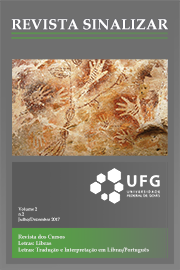The influence of portuguese language on the production of Libras in the translanguaging perspective
DOI:
https://doi.org/10.5216/rs.v2i2.36080Keywords:
Bilingualism. Portuguese. Libras. TranslanguageAbstract
The aim of this paper is to discuss the influence of Portuguese on the production of Libras in the translanguaging perspective, a concept presented by García (2009), for the contact of these languages results in a production that exceeds the traditional conceptual limits on the phenomena of languages in contact. It is an interpretive case study carried out through the analyses of a text written in Portuguese by two deaf students who sign Libras. The results showed the influence of Portuguese on Libras for the usage of linguistics elements belonging to Portuguese that neither exist nor are signed in Libras, but were included in the statements of the students during the discussions while producing the text. The analysis also revealed that the students, besides choosing to use the most appropriate modality (written or signed) and merge the languages, they also engaged in multiple discursive practices to cobuild meanings and social identities in their bilingual worlds, or they simply translanguaged.
Downloads
References
ANDRÉ, M. E. D. A. Etnografia da prática escolar. Campinas, SP: Papirus, 1995.
AUER, P. The pragmatics of code-switching: a sequential approach. In: MILROY, L.; MUYSKEN, P. (Ed.). One speaker two languages: cross-disciplinary perspectives on code-switching. New York: Cambridge University Press, 1995. p. 115-135.
BATTISON, R.. Lexical borrowing in American Sign Language. Silver Spring, Md.: Linstok Press, 1978.
BLOM, J.P. ; GUMPERZ, J.J. Social meaning in linguistic structures: code-switching in Norway. In: GUMPERZ, J.J.; HYMES, D. (Ed.). Directions in Sociolinguistic: the ethnography of communication. New YorK: Holt, Rinehart, Winston, 1972. p. 407-434.
BLOOMFIELD, L. Language. New York: Henry Holt and Company, 1933.
BORTONI-RICARDO, S. M. Educação em língua materna: sociolinguística em sala de aula. 6 ed. São Paulo: Parábola Editorial, 2009.
CARVALHO, N. Empréstimos linguísticos. São Paulo: Ática, 1989.
ELLIS, R. The study of second language acquisition. London: Oxford University Press, 1994.
_________. Learning second language through interaction. Amsterdam: J. Benjamins, 1999.
FARIA-NASCIMENTO, S.P. Representações Lexicais da Língua de Sinais Brasileira: Uma Proposta Lexicográfica. Brasília: UNB, 290 f. Tese (doutorado) – Instituto de Letras, 2009.
FELIPE, T. A.; MONTEIRO, M. S. Libras em contexto: curso básico. 7ªed. Rio de Janeiro: WallPrint, 2008.
FERNANDES, S. Avaliação em língua portuguesa para alunos surdos: algumas considerações. In: Secretaria de Educação do Estado do Paraná. Superintendência da Educação. Departamento de Educação Especial. Curitiba: SEED/SUED/DEE, 2007.
GARCIA, O. Bilingual and Translanguaging. In: GARCIA, O. Bilingual education in the 21st century: a global perspective. United Kingdom: Willey-Blackwell, p. 42-71, 2009.
GARCIA. O; WEI. L. Translanguaging: language, bilingualism and education. Basingstoke: Palgrave Macmillan, 2014.
GOFFMAN, E. Forms of talk. Oxford: Basil Blackwell, 1981.
GROSJEAN, F. Bilingual: Life and reality. Cambridge, Massachusetts, London: Harvard University Press, 2010.
GUMPERZ, J. J. Discourse strategies. Cambridge: Cambridge University Press, 1982.
GUTIÉRREZ, K. D., BAQUEDANO-LÓPEZ, P.; ALVAREZ, H. H.; Literacy as hybridity: moving beyond bilingualism in urban classrooms. In: REYES, M. L.; HÁLCON, J. J. (Ed.) The Best for our Children: Critical Perspectives on Literacy for Latino Students. . New York and London: Teachers College Press. 2001, p.122-141
HAUGEN, E. The ecology of language. Stanford: Stanford University Press, 1972. Disponível em: http://history.lzu.edu.cn/editor/asp/upfiles/file/201504/20150413155755110.pdf>. Acesso em: 13 ago. 2015.
JACOBSON, R. Can two languages be developed concurrently? Recent developments in bilingual methodology. In: Altman, H. B.; MCCLURE, M. G. (Ed.). Proceedings of the 18th southern conference on language teaching. Atlanta, GA: Southern Conference on Language Teaching, Spelman College, 1983. p. 110-132.
JACOBSON, R.; FALTIS, C. Language distribution issues in bilingual schooling. Clevedon: Multilingual Matters, 1990.
LUCAS, C; VALLI, C. Language contact in the American deaf community. In: VALLI, C.; LUCAS, C.; MULROONEY, K. J.; VILLANUEVA, M. Linguistics of American Sign Language: an introduction. 5. ed. Washington, DC: GallaudetUniversity Press, 2011. p.542-564.
LÜDKE, M; ANDRÉ, M. E. D. A. Pesquisa em educação: abordagens qualitativas. São Paulo: E.P.U., 1986.
MACNAMARA, J. The bilingual’s linguistic performance: a psychological overview. Journal of Social Issues. v. 23, n. 2, p. 58-77, 1967.
MACKEY, W. The Description of Bilingualism. In: WEI, L. The bilingualism reader. London: Routledge, 2000.
MELLO. H. A. B. Educação bilíngue: uma breve discussão. Horizontes de Linguística Aplicada, v. 9, n.1, p. 118-140, 2010.
NASCIMENTO, C. B. Alfabeto Manual da Língua de Sinais Brasileira (LIBRAS): uma fonte produtiva para importar palavras da língua portuguesa. Revista Trama, v. 7, n. 14, p. 33- 55, 2011.
POPLACK, S. Sometimes I’ll start a sentence in Spanish y termino en Español: toward a typology of code-switching. Linguistics, v. 18, n. 7/8, p. 581-618, 1980.
QUADROS, R.M.; KARNOPP, L. B. Língua de Sinais Brasileira: Estudos linguísticos. Porto Alegre: Artmed, 2004.
QUADROS, R.M. O bi do bilingüismo na educação de surdos In: Surdez e bilinguismo. Porto Alegre: Editora Mediação, v. 1, p. 26-36, 2005.
QUADROS, R.M; PIMENTA, N. Curso de Libras1. Rio de Janeiro: LSB Video, 2006.
SAYER, P.. Translanguaging, TexMex, and Bilingual Pedagogy: Emergent Bilinguals Learning Through the Vernacular. TESOL QUARTERLY, v. 47, n. 1, mar 2013.
WEINREICH, U. Languages in contact. The Hague: Mouton, 1974.
THOMASON, S. G.; KAUFMAN, T. Language contact, creolization and genetic linguistics. Berkeley: University California Press, 1988.
VALDÉS, G. Code-switching as a deliberate verbal strategy: a microanalysis of direct and indirect requests among Chicano bilingual speakers. In: DURAN, R. (Ed.) Latino languageandccommunicativebehavior. Nowoodm New Jersey: Ablex, 1981. p. 95-108.
VAN LIER, L. The classroom and the language learner. Essex: Longman, 1988.
ZENTELLA, A. C. Growing up bilingual: Puerto Rican children in New York. Malden, MA: Blackwell, 1997.
Downloads
Published
How to Cite
Issue
Section
License
Copyright

This work is licensed under a Creative Commons Attribution-NonCommercial-NoDerivatives 4.0 International License.
Autores que publicam nesta revista concordam com os seguintes termos:
Autores mantém os direitos autorais e concedem à revista o direito de primeira publicação, com o trabalho simultaneamente licenciado sob a Creative Commons Attribution License que permitindo o compartilhamento do trabalho com reconhecimento da autoria do trabalho e publicação inicial nesta revista.
Autores têm autorização para assumir contratos adicionais separadamente, para distribuição não-exclusiva da versão do trabalho publicada nesta revista (ex.: publicar em repositório institucional ou como capítulo de livro), com reconhecimento de autoria e publicação inicial nesta revista.







